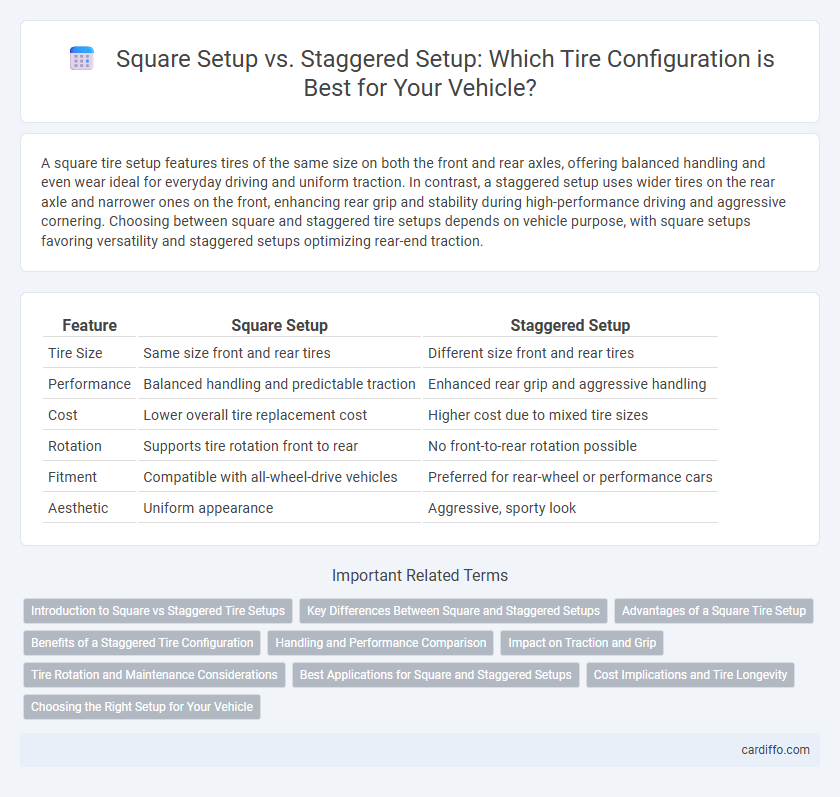A square tire setup features tires of the same size on both the front and rear axles, offering balanced handling and even wear ideal for everyday driving and uniform traction. In contrast, a staggered setup uses wider tires on the rear axle and narrower ones on the front, enhancing rear grip and stability during high-performance driving and aggressive cornering. Choosing between square and staggered tire setups depends on vehicle purpose, with square setups favoring versatility and staggered setups optimizing rear-end traction.
Table of Comparison
| Feature | Square Setup | Staggered Setup |
|---|---|---|
| Tire Size | Same size front and rear tires | Different size front and rear tires |
| Performance | Balanced handling and predictable traction | Enhanced rear grip and aggressive handling |
| Cost | Lower overall tire replacement cost | Higher cost due to mixed tire sizes |
| Rotation | Supports tire rotation front to rear | No front-to-rear rotation possible |
| Fitment | Compatible with all-wheel-drive vehicles | Preferred for rear-wheel or performance cars |
| Aesthetic | Uniform appearance | Aggressive, sporty look |
Introduction to Square vs Staggered Tire Setups
Square tire setups feature identical tire sizes and widths on all four wheels, providing uniform wear, straightforward rotation, and balanced handling characteristics. Staggered setups utilize wider rear tires than the front, enhancing rear grip and stability, especially in high-performance or rear-wheel-drive vehicles, at the cost of front tire rotation flexibility. Selecting between square and staggered setups depends on vehicle type, driving style, and performance goals, influencing traction, cornering, and maintenance considerations.
Key Differences Between Square and Staggered Setups
Square tire setups use identical tire sizes on all four wheels, promoting even tire wear and simplifying tire rotation, ideal for balanced handling and extended tire life. Staggered setups feature wider rear tires than front, enhancing rear-wheel traction and providing a more aggressive stance suited for high-performance and rear-wheel-drive vehicles. The key differences lie in tire size uniformity, handling characteristics, and maintenance demands, with square setups favoring versatility and staggered setups prioritizing performance optimization.
Advantages of a Square Tire Setup
A square tire setup uses tires of the same size on all four corners, promoting even tire wear and simplifying tire rotation. This uniformity enhances vehicle balance and handling stability, especially in all-wheel-drive systems where equal traction is crucial. Maintenance costs are reduced due to interchangeable tires, maximizing tire lifespan and improving overall performance consistency.
Benefits of a Staggered Tire Configuration
A staggered tire configuration enhances vehicle handling by using wider rear tires, which improve traction and stability during acceleration and cornering. This setup also promotes better weight distribution across the drive wheels, leading to increased grip and reduced tire wear. Performance vehicles benefit from the staggered arrangement as it optimizes power delivery and enhances overall driving dynamics.
Handling and Performance Comparison
Square tire setups, featuring identical tire sizes on all four wheels, enhance balanced handling and predictable vehicle dynamics during cornering, offering equal traction and wear. Staggered setups, with larger rear tires compared to the front, improve rear-end grip and straight-line acceleration but may lead to understeer and less uniform tire wear. Racing and performance cars often prefer staggered setups for aggressive handling, while square setups suit balanced performance and easier tire rotation.
Impact on Traction and Grip
Square tire setups, where all four tires have the same size and dimensions, provide balanced traction and uniform grip on both front and rear axles, enhancing predictable handling in various driving conditions. Staggered setups, featuring wider tires on the rear axle, improve rear-end grip and traction, particularly during acceleration and cornering, but may reduce front-end steering responsiveness. Choosing between square and staggered setups depends on desired performance characteristics, with staggered tires often favored for increased rear traction and sporty handling dynamics.
Tire Rotation and Maintenance Considerations
Square setup features identical tires on all four wheels, allowing for straightforward tire rotation patterns that maximize tire life and balance wear evenly across all tires. Staggered setups, with different tire sizes on the front and rear, limit rotation options primarily to side-to-side swaps, which can lead to uneven wear and may require more frequent monitoring and maintenance. Proper tire rotation in square setups extends tire longevity and improves vehicle performance, while staggered setups demand careful maintenance to ensure optimal traction and handling.
Best Applications for Square and Staggered Setups
Square tire setups, where all four tires are the same size and type, are best suited for daily driving and balanced performance, providing even tire wear and straightforward rotation. Staggered setups, featuring larger rear tires and smaller front tires, are ideal for high-performance and rear-wheel-drive vehicles, offering enhanced traction and cornering stability. Enthusiasts seeking maximum handling precision and aggressive aesthetics often prefer staggered setups for sports cars and track applications.
Cost Implications and Tire Longevity
A square tire setup, featuring identical tires on all four wheels, typically reduces costs due to interchangeable tires and uniform wear, resulting in easier and less expensive maintenance. In contrast, a staggered setup, with wider tires on the rear axle, often leads to increased tire expenses because of varied tire sizes and quicker wear on front tires due to differing traction demands. Tire longevity generally favors the square setup since uniform tire size promotes even wear patterns, whereas staggered setups may cause uneven wear and more frequent tire replacements, impacting overall cost-effectiveness.
Choosing the Right Setup for Your Vehicle
Selecting the right tire setup depends on your vehicle's drivetrain and handling preferences. Square setups use identical tire sizes on all four corners, promoting uniform grip and even wear, ideal for all-wheel-drive vehicles. Staggered setups feature wider rear tires than the front, enhancing rear traction and aggressive styling, typically favored by rear-wheel-drive performance cars.
Square Setup vs Staggered Setup Infographic

 cardiffo.com
cardiffo.com